You’re probably as eager as I am for new images of Pluto and Ceres as both New Horizons and Dawn push ever closer to their respective little worlds. Recent photos, of which there are only a few, reveal some wild new features including what appears to a large crater on Pluto.
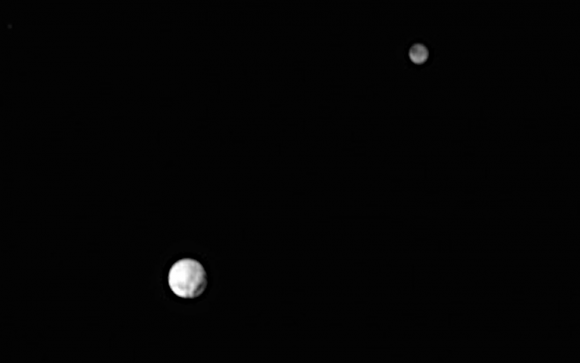
In the end, this apparent large impact might only be a contrast effect or worse, an artifact of over-processing, but there’s no denying its strong resemblance to foreshortened, shadow-filled craters seen on the Moon and other moons. It’s also encouraging that an earlier photo from June 27 shows the same feature. But the “crater” is just so … big! Its size seems disproportionate to the Pluto’s globe and recalls Saturn’s 246-mile-wide moon Mimas with its 81-mile-wide crater Herschel.
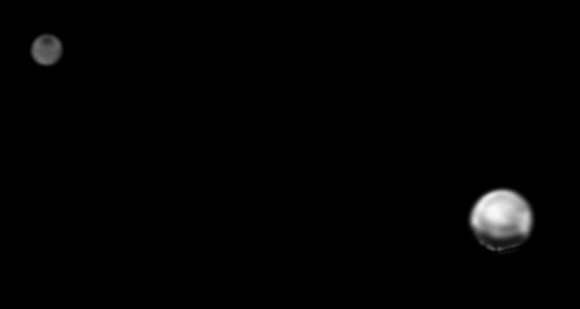
Astronomers speculate the impact that gouged out Herschel came perilously close to shattering the moon to pieces. If it does turn out to be an crater, Pluto’s surface opposite the impact will likely show many fractures. Not to be outdone, the dwarf planet’s largest moon, Charon, is starting to show a personality of its own with a prominent dark north polar cap.
Since polar caps are normally bright, icy features, some have referred to this one as an “anti-polar cap”. Speaking of ice, the bright rim around Pluto in the photo above may be nitrogen frost condensing out of Pluto’s scant atmosphere as it slowly recedes from the Sun. Think how cold it must have to get for nitrogen to freeze out. How about -346° F (-210° C)! For new images of the Pluto system, be sure to check the New Horizons LORRI gallery page.
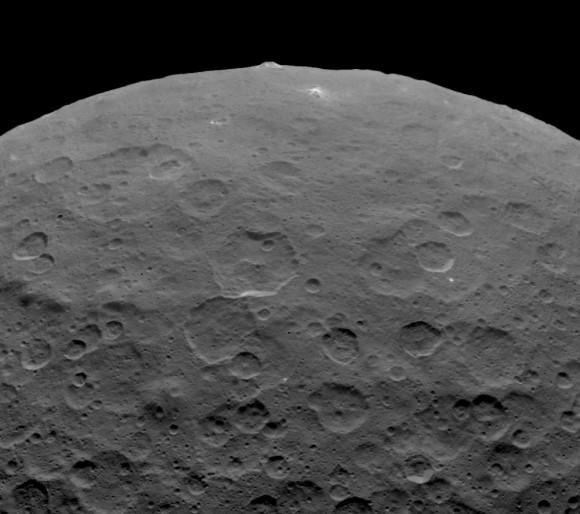
Closer to home, new photos of Ceres show a peculiar, pyramid-shaped mountain towering 3 miles (5 km) high from a relatively smooth region between two large craters. Mountains poking from crater floors aren’t unusual. They’re tossed up after the crust later rebounds after a large impact. What makes this one unusual is the lack of an associated crater. Moreover, the mountain’s pale hue could indicate it’s younger than the surrounding landscape. As far as we can tell, it’s the only tall mountain on the face of the dwarf planet.
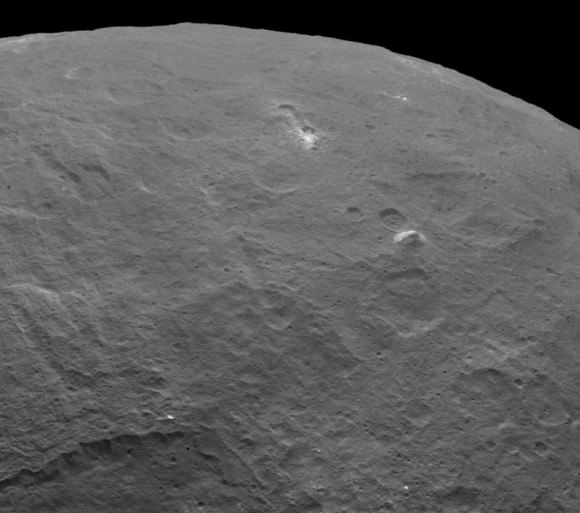
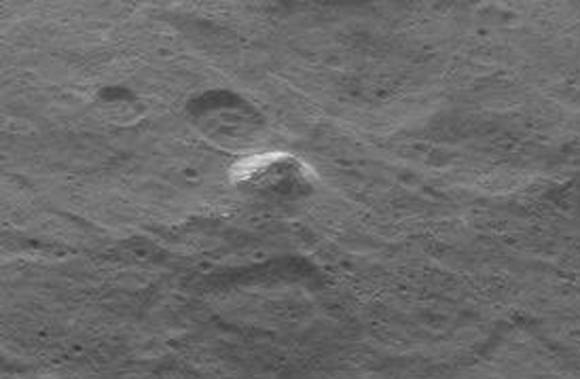
The Dawn team also photographed that cluster of white spots again, this time with a very shot exposure in to eke out more details. What do you think? If you’re as interested in asteroids as I am, Italian astrophysicist Gianluca Masi, a frequent photo contributor to Universe Today, will host a special live Asteroid Day event today starting at 6 p.m. CDT (23:00 UT). Masi will review near-Earth asteroids, explain discovery techniques and observe several in real time.
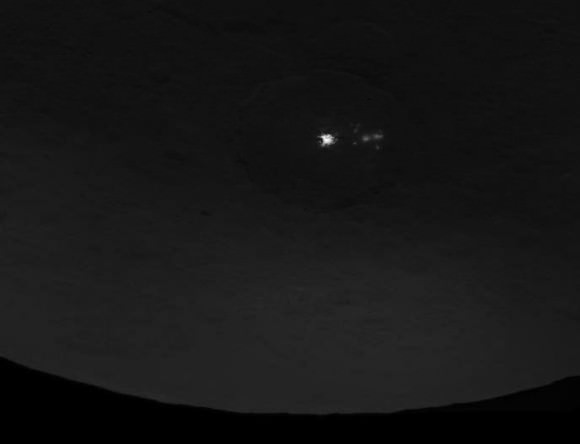
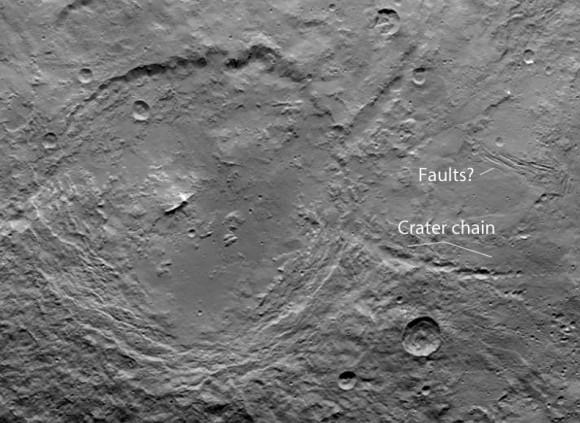

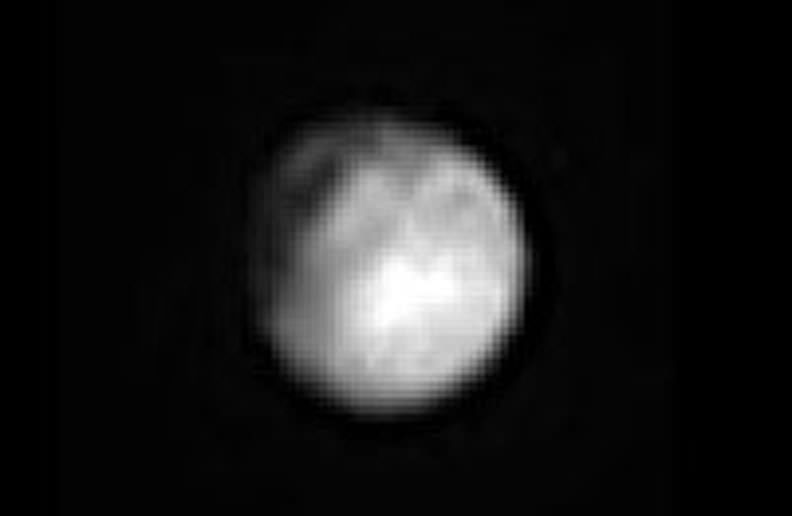
Ahso.. things are getting curiouser and curiouser!
In the forth image back, showing “Another more overhead view of the mountain…”, above and to the left is another bright spot which appears associated with a well defined crater. Continuing along a line between the mystery mountain and this bright spot something like a canyon is visible? A series of collapse craters?
You noted the striations on that mountain, I’m sure you must have also noticed, in the overhead shot other fault lines running parallel to the mountain’s striations? I wonder if there is a relationship with a giant impact? Could those features indicate impact compression faulting? such as seen on other asteroids and comets? Too early to say? but we’ll know soon enough!
Aqua,
Yes, good observation about the fault line. Is it related to the mountain? Maybe. With no associated crater however I wonder if it might not be something similar to a lunar volcanic dome (cryo-dome?) though at 5 km it seems absurdly high for that.
Yes.. that translates into 3.1 miles up! or roughly 16,368 feet. The low gravity making that possible? Cryo-dome sounds right, much better than something exotic, like a passing miniature black hole?
Absurdly high by earth geologic standards, of course, but in the lower gravity of Ceres not so absurd, perhaps. Olympus Mons on Mars is absurdly high, but it was not constrained by earth-like shifting plate tectonics in its formation, which took place all in one location.
Could that giant crater on Pluto have been caused by the impact that created Charon?
Hi Laurele,
Fascinating thought. Maybe, but let’s see whether the crater’s real.
The pyramid on Ceres is soon to be explained by a new theory which describes how the great pyramids of Giza formed naturally. Maybe by some impact, or volcanism, or sand storms or crystallization or erosion or whatever. If pyramids form naturally on Ceres then they must form naturally on Earth too.
Pyramids are simple geometric shapes, easy to explain. Admittedly, that giant sphinx with a woman’s face, a lion’s body and an eagle’s wings, is a bit harder to explain with random chance. But statistically it is only one outlier out there lying to us… (or maybe there are many small sphixes in Egypt? Damn it for cosmology!)
Apologies if you’re being satirical in your post (there’s no smilies or other subtle clues to indicate this) – but the Great Pyramids and The Sphynx were definitely not constructed by geological processes.
They’re actually made up of thousands of individual blocks of rock that have been expertly crafted by Egyptian stone-masons and somehow dragged into place using brute force / slave labour / ingenious lost ancient technologies (there’s still much debate about the logistics of how this was achieved given the extreme weight of each precision-carved block).
Geologists have even worked out the specific sites from where the stone was excavated.
You forgot the temple at Karnak. And the library of Alexandria. And the Falafel King drive thru in Cairo.
Keep in mind that the images from New Horizons are nearly “full moon” like and so apparent shadows/highlights that you’d normally use to distinguish craters are not present. So you can’t really say it’s a crater … yet.
Astrostu,
Good point. That’s why I was careful to consider alternatives and use ” ” around “crater”.
Name the craters after pornographic movie stars. My favorite is Dagmar. Want to marry him now that it is legal and our new way of life !
http://i2.wp.com/www.universetoday.com/wp-content/uploads/2015/06/Pluto-June-27-20.9mK-BaalkeProcess_L.jpg
Clearly, we can see that Pluto is formed by clearing Minecraft blocks from the outer solar system.
A yemeni researcher in astronomy Adnan Al-Shawafi precedes NASA in
explaining the facts about Pluto
The media center of New Horizon (a space mission to explore Pluto the
planet) has published in 22 June 2015 fresh photos of Pluto taken from
a closer distance as the Spaceship got nearer showing that the planet
is more than double in size compared to previous photos. The new
photos revealed that Pluto is not perfectly spherical despite earlier
announcement by the same center (11 June 2015) in which they ruled out
Pluto is not spherical even it appeared like that due to technical
failure in processing the then photos. But when those photos were
analyzed by the researcher Adnan Al Shawafi, he concluded that the
planet is not spherical in shape and those conclusions have been sent
to NASA on 22nd of June 2015 and were published on that same date in
his own blogging snd related forums as well as social media networks.
Yemeni news websites followed suit and published his conclusions
asserting that Pluto is not perfecly spherical or elliptical on 23rd
of June 2015 plus other findings arrived at by the researcher based on
his self-concluded theory on Compound Balance Balls revealed in 2013.
Hence, this shall be considered a prescience by the researcher and an
assertion of the scientific power of the theory he relied on.
In this respect, the researcher says that he didn’t imitates the
approach followed by NASA and other science bodies in charge of the
New Horizon mission when it comes to explaining the layout of of photo
taken. Meanwhile, my hypothesis is built on eight laws and eight math
formulas all of them concentrated on the coordinates of Pluto planet
and its moon using the previously taken photos which NASA failed to
conclude – using those same old photos – to reveal whether the planet
is not spherical and announced vague explanations.
The researcher says also that he is pleased to table his scientific
explanation to NASA so to understand the
rebound movement (vibratory – both the planet and its moon move back and fro and never moves in a fixed elliptical orbit). Such movement,
he says, is due to the fact that the planet is not perfectly spherical
which goes against NASA conclusion describing the planet movement as
“orbital dance” without explaining what cause such movement. NASA
scientists going to say the reason is that the Planet body center is not
located right in the center i.e. one part has more mass than the
other, and this is not a reasonable evidence though the researcher has
raised such issue to assure that we do understand what they have and
what we do and that no announcement made yet to show that the dual
mass center outside the planet is changing and not at the same
distance from the planet. I do hope that NASA reveals such
informations in the days to come.
Researcher conclusions was entitled ” A Yemeni astronomy researcher
tables some inquires for NASA to explain the vagueness facing Apollo
mission to understand the variation in the glow on the Pluto surface ”
and it was as follows .
New Horizon is a NASA- sponsored mission which is set to study Pluto –
the Planet- and its moons as well as the Cabiier belt. This spaceship
was launched in 19 June 2006 from the earth and has been speeding up
and accelerating to reach the tiny planet “Pluto”. It runs at an
average speed on 1 million KM/day and , thus, considered to be the
speediest man-made machine. It was expected to reach the target by14
June 2015. The mission has succeeded in taking some photos of the
Pluto and recently scientists and New Horizon Team have been
considering the closest photos taken of the planet this year, which
shows a great variation in the shining surface of the Pluto amid some
explanations, which said that it was due to the polar cover.
Nevertheless, scientists and analyzing team at New Horizon still face
a lot of opacity in explaining the photo taken.
Early on, the Yemeni scientists Adnan Al Shawafi – astronomy
researcher – has been following the mission and all materials
published to that end. After examining and analyzing the photos, Mr.
Al Shawafi arrived at two conclusions or, more correctly, the same
finding with two different explanations as follows:
First conclusion: it is based on applicable laws and concepts which
says that the variation in shininess is due to the irregular shape of
Pluto since it is not a perfectly spherical or elliptical and the
evidence of that is its regressive movement (vibratory movement back
and fro and never moves in a regular elliptical orbit) around its
A common center of mass located outside its center. The same regressive movement
applies its double moon Sharon i.e. the distance between Sharon the
moon and Pluto the planet is changing up and down but it was not
recognizable because of the narrow vision angle. The Charon orbital
movement around the Pluto. No attention was given as well because the
Moon surface movement is irregular since Charon day equals its month
and that the time it takes to rotate around itself equals the time
used to rotate around Pluto. Therefore, the vision dimensions of Charon
and its surface is fixed all the time with Pluto.
The reason why the distance between the planet and its moon keep
changing can also be attributed to the fact that Pluto’s mass is not
concentrated in the center of the planet. In other words, if we break
it into halves, we will see that one half has larger mass than the
other half by over 20%. This explanation is developed following an
in-depth study of the probabilities and on the applicable concepts.
The second conclusion: is the same explanation of movement furnished
in the hypothesis tabled by the researcher Adnan Al Shawafi and
published in 2013 which contains 8 laws and 8 math formulas explaining
the balance of orbs in compound universal systems as well as
additional dimensions of the universe. In his hypothesis, the
researcher developed a set of explanations and predictions concerning
planet Pluto including its common balance with its moon Sharon and
that Pluto is rotating around a factitious center outside its body at
a distance of 5400 km though the existing laws and circulated
information did not conclude to even 50% of the distance concluded by
the researcher even before publishing his hypothesis and related
articles on the balance of planet Pluto published in the web and key
words can be used to search for these submissions.
My publications were to show my persistence and confidence in my
hypothesis and the dimensions of the Pluto being a spherical in shape
with an approximate area of its space 16.69 million km2. The newly
released photos obtained from New Horizon asserts the fact that
Pluto’s shape is irregular and that the distance can go up and down by
20% which is still double the distance known and proven by gravity
laws and other laws in use although I believe there is a 100%
difference in the estimated distance between Pluto center and the
common center of mass outside Pluto’s according to the Balance
Balls hypothesis.
Hence, the researcher Adnan Al Shawafi calls on NASA and New Horizon
mission to pay due attention to his explanations and conclusions
elucidating the variation found in the photos taken by New Horizon
which he deemed it worth sharing to further analyze the vagueness
under question.
All rights reserved
Hopefully we’ll see fresh images of Pluto in the very near future that will clear up whether or not it is irregular in shape.
It is possible that the recent jagged-looking image was the result of image capture / processing artifacts (space is a difficult environment in which to capture good quality images – and often there are strange artifacts present in images resulting from the lossy nature of techniques used to capture and enhance the imagery).
We’re only a few short weeks from the best view of Pluto we’ll likely have for many decades.
If it is a massive crater on Pluto and it is dynamically young, are there bodies in the solar system other than the pluto system that could be sourced to such a collision? Such might appear to be comets…
ah… http://adsabs.harvard.edu/abs/2004KFNT…20..283G
I’ve been on the edge of my seat since 2006 waiting for this encounter. The final [original] planet revealed at last. Oh happy day!! 😉
Can someone help me out? In the last picture of this story, Dawn has taken a very high resolution close up picture of a crater on Ceres. Yet when it comes to the “Bright Spots” of Ceres, the pictures are grainy and appear to show very little detail as well as being the furthest thing from a close up. As a matter of fact, it looks like the zoom feature has been set to show the widest area possible of Ceres, when looking at the “Bright Spots”. Why the disparity in detail?